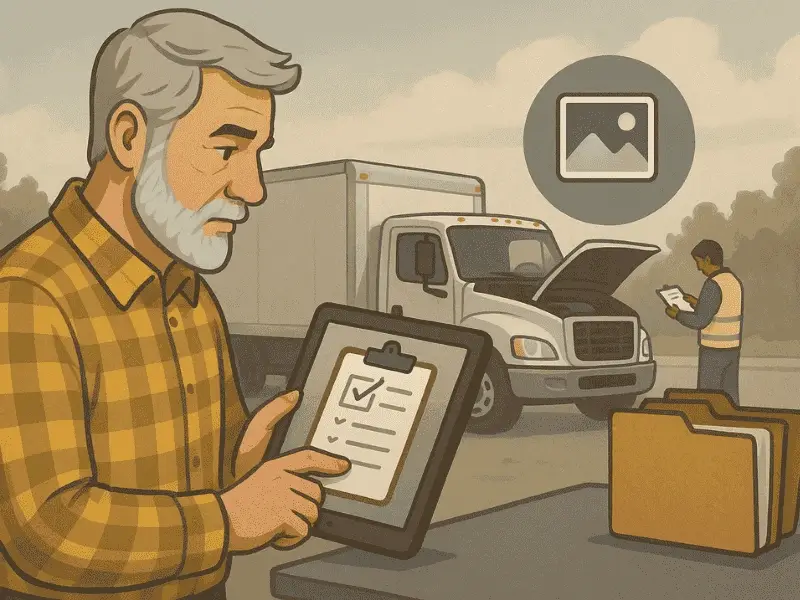Key Takeaways
- Define your needs before starting a CMMS evaluation.
- Look for key work order software features like mobile work orders and cost reporting.
- Assess current challenges to find the right fit.
- Budget realistically, considering ROI and scalability.
- Use a buyer’s guide checklist to simplify vendor comparisons.
When your fleet or facility depends on uptime, every maintenance task counts. Missed work orders, stockouts, or mismanaged spare parts can result in downtime, higher costs, and unhappy customers. That’s why choosing work order software with the right capabilities is one of the most important decisions maintenance managers and fleet leaders can make.
This guide breaks down the key steps, features, and checklist items you should evaluate before selecting a work order and inventory management solution. Whether you’re considering a Computerized Maintenance Management System (CMMS) or exploring other options, you’ll find actionable insights here to help you make the best decision for your organization.
Why Choosing the Right Work Order Software Matters?
Work order and inventory management tools are more than task trackers. They are the backbone of a streamlined maintenance system, keeping your fleet or facility on schedule, preventing breakdowns, and ensuring the right parts are available at the right time.
Without a robust solution:
- Work orders get lost in emails or paper files.
- Inventory is either overstocked or unavailable when needed.
- Costs spiral due to reactive repairs.
With the right solution:
- Maintenance is proactive.
- Teams collaborate in real time.
- Inventory levels stay balanced, reducing waste and delays.
Steps to Follow While Choosing the Right Work Order & Inventory Management Tool
Step 1: Define Your Maintenance Needs
Before looking at vendors, start with your operations.
Ask yourself:
- How many assets and locations are you managing?
- Are you tracking preventive maintenance schedules or mainly handling emergency repairs?
- Do you need multi-location inventory tracking?
The answers will shape your requirements. For example, a small fleet may need a simple CMMS evaluation, while a large enterprise may require a solution that integrates with ERP systems.
Checklist Item: Write down your top 5 maintenance pain points and the outcomes you want to achieve.
Step 2: Understand Your Challenges
Choosing software is about solving real problems. Think about where your current process fails.
Common challenges include:
- Lack of visibility into open work orders.
- Delays due to missing parts or inaccurate stock data.
- Limited reporting or analytics for leadership.
- Manual, time-consuming data entry.
Checklist Item: Identify 3–4 recurring challenges your team faces. This will guide you in maintenance system selection.
Step 3: Budget for More Than the Purchase Price
Work order and inventory software comes in a wide range of pricing models, from free basic apps to enterprise-grade systems costing thousands per month.
Key considerations:
- Licensing: per user or per asset?
- Subscription vs. one-time fees.
- Add-ons for reporting, integrations, or mobile access.
- Ongoing support and upgrades.
Remember, the cheapest solution may not scale with your needs. Balance affordability with long-term growth potential.
Checklist Item: Define your budget range and acceptable ROI timeline.
Step 4: Prioritize Integration
Your new tool should not operate in isolation. It must integrate with the systems you already use.
Examples:
- CRM systems for customer work requests.
- ERP software for financial tracking.
- Fuel and telematics data for fleet management.
Poor integration creates silos and inefficiencies, while smooth integration boosts productivity across departments.
Checklist Item: List the 3–5 systems your software must integrate with.
Step 5: Decide Who Will Access the System
Licensing models often depend on the number of users. Decide early who needs access:
- Maintenance technicians.
- Inventory managers.
- Supervisors and fleet managers.
- External suppliers or contractors.
In some cases, granting suppliers limited access can streamline reorders and reduce downtime.
Checklist Item: Create a list of required users and roles.
Must-Have Features in a Work Order & Inventory Tool
When doing your CMMS evaluation, make sure your software includes:
Buyer’s Guide Checklist for Choosing Work Order Software
Here’s a quick buyer’s checklist to keep handy:
- Define maintenance needs (assets, locations, preventive vs. reactive).
- List recurring challenges to solve.
- Establish budget and ROI expectations.
- Identify integration requirements.
- Determine user access and roles.
- Evaluate feature list (mobile, inventory, reporting, preventive, etc.).
- Shortlist 3 vendors and request demos.
- Compare support, training, and scalability options.
Download Our Free Fleet Maintenance Resources
Final Thoughts
Selecting the right work order and inventory management tool requires a thoughtful approach. By using this buyer’s guide and checklist, you’ll be well-equipped to evaluate vendors, compare features, and choose a system that reduces downtime, optimizes inventory, and supports long-term growth.
At Simply Fleet, we help companies like yours streamline operations with intuitive, mobile-first maintenance solutions. Our platform makes it simple to manage work orders, track inventory, and generate insightful reports, all in one place.
Request a demo today and see how Simply Fleet can help you cut costs and improve efficiency.



.png)








.png)


.png)




.webp)


.png)



